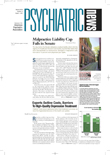Senate legislation that would have imposed limits on noneconomic damages in medical liability cases was defeated last month despite support from the American Medical Association, APA, and more than 50 other groups representing physicians, insurers, and patients.
The Patients First Act (S 11) would have capped noneconomic damages—also known as damages for “pain and suffering”—at $250,000. The bill, introduced on June 27 by Sen. John Ensign (R-Nev.) with 10 co-sponsors, is similar to the HEALTH (Help Efficient, Accessible, Low-Cost, Timely Healthcare) Act (HR 5), which passed the House of Representatives by a 229-196 vote on March 13.
Senate Democrats, who opposed the bill to cap noneconomic damage awards, blocked an effort by Republicans to end debate and call the bill to the floor for consideration. The cloture vote failed by 49-48, short of the 60 votes required to limit debate.
Prior to the cloture vote, which essentially defeats the bill, the AMA had been vigorously campaigning for it, drawing special attention to the opposition by the nation’s trial lawyers.
“Senators must understand that doctors are being forced to make hard choices to limit procedures, refer high-risk cases, and retire early,” AMA President Donald J. Palmisano, M.D., said before the vote. “Without federal legislation, patients will bear the brunt of this crisis as access to care in many high-risk medical specialties becomes limited.
“While the trial lawyers continue to hide behind smokescreens and roadblocks, liability-insurance premiums rise to staggering levels for many physicians,” Palmisano said.
As the debate in the Senate was progressing, the AMA was running medical liability radio ads in key states with key senators, including Alabama, Arkansas, Nebraska, Pennsylvania, and South Carolina. “In the last two months both patients and physicians have told Congress how important it is for them to pass medical liability reform,” Palmisano said. “Over 26,000 patients have contacted the AMA to get involved in the fight for medical liability reform and have generated more than 50,000 communications with members of Congress.”
Following defeat of the bill, President George Bush issued a statement urging Congress to pass liability reform.
“I am disappointed that the Senate has failed to pass medical liability reform legislation,” the president said. “The nation’s medical liability system is badly broken, and access to quality health care for Americans is endangered by frivolous and abusive lawsuits. . . .The American people want and deserve access to doctors in their own communities, yet the number of physicians has decreased in states without reasonable litigation reforms. The liability crisis, particularly the use of defensive medicine, also imposes substantial costs on the federal government and all Americans.
“For the sake of all Americans,“ the president said, “it is time for the Senate to pass meaningful medical reform liability legislation and get it to my desk.”
But Democrats, who opposed the bill, say the steep increases in liability premiums in some parts of the country have been caused by insurers who maintained premiums at artificially low levels for years to gain more customers, making up for the low prices with big gains on stock market investments. When the market declined, insurers raised premiums dramatically.
APA Backs Reform Bills
Michael Strazzella, deputy director for congressional relations in APA’s Division of Government Relations, pointed out that APA supported this bill and other federal malpractice reform efforts, as a member of the Health Coalition on Liability and Access.
The coalition includes more than 50 organizations representing physicians, insurers, and patients.
“APA regrets that the Senate did not pass medical liability reform legislation but strongly urges senators to continue to examine the issue and find a solution to this national crisis,” Strazzella said.
Caps Affect Physician Supply
In related news, the Agency for Healthcare Research and Quality (AHRQ) released a report showing that states that have enacted limits on noneconomic damages in medical lawsuits have about 12 percent more physicians per capita than states without such a cap.
The study looks at the growth of the physician workforce since 1970, before any state had enacted caps, and adjusts for the impact of other factors believed to affect physician supply, such as per-capita income and the presence of physician residency programs.
What the study found was that physician supply has grown more in states with caps than in states without caps.
According to the study’s authors, Fred Hellinger, Ph.D., and William Encinosa, Ph.D., “These findings demonstrate that state laws limiting noneconomic damages in medical malpractice cases increase the number of physicians who practice in the states.”
Both authors are with the AHRQ’s Center for Organization and Delivery Studies.
They found that by 2000, states that had enacted caps had a significantly higher number of doctors (135) per 100,000 county residents compared with states that didn’t enact caps (120 per 100,000). In 1970 there was no statistically significant difference between states in their per capita supply of physicians, according to the study.
The study, released on the day debate commenced in the Senate on the Ensign bill, was hailed by the administration as proof of the need for medical liability reform.
“Our broken medical litigation system is affecting patients’ ability to find a doctor,” Health and Human Services Secretary Tommy Thompson said. “This study confirms and quantifies the association between reasonable limits in medical lawsuits and the supply of physicians available to treat patients who need them. It is critical that we fix this broken litigation system now. In the current system, the fear of excessive awards stimulates wasteful defensive medicine and deters doctors and hospitals from identifying and addressing medical errors, thus increasing costs and decreasing quality.”
The AHRQ study, “Impact of State Laws Limiting Malpractice Awards on Geographic Distribution of Physicians,” is posted on the Web at www.ahrq.gov/research/tortcaps/tortcaps.htm. More information about the coalition, Senate bill S 11, and other liability reform efforts is posted on the Web at www.hcla.org/. ▪
